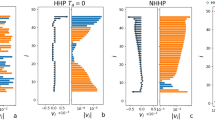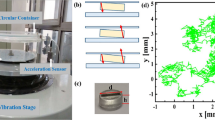Abstract
A kinetic theory1,2 of granular media, analogous to that described by Maxwell–Boltzmann statistics for molecular gases and liquids3,4, has long been sought in the quest for a continuum theory. Here we present results from a two-layer, vertically vibrated granular system, in which an oscillating plate drives a horizontal layer of heavy grains, which in turn drives an overlying horizontal layer of lighter grains. In the second layer, but not in the first, we find that the velocity distributions are gaussian — a result that is observed for a wide variety of driving and density parameters, indicating that the second layer's behaviour is much more gas-like than was previously seen in driven granular media. This similarity to molecular gases brings a kinetic theory of granular media a step closer.
Similar content being viewed by others
Main
Attempts to apply a kinetic theory to granular media have been undermined by their observed non-gaussian velocity distributions5,6,7,8,9,10,11,12, which are inconsistent with Maxwell–Boltzmann statistics. We have designed a set-up (Fig. 1a) in which a two-layer granular medium is shaken vertically on a horizontal plate. The plate moves as x(t) = A × sin(2πft), which corresponds to a dimensionless acceleration of Γ = (2πf)2/g where f is the oscillation frequency, A is the oscillation amplitude and g is the acceleration due to gravity. The plate's circular sidewall is topped by a Plexiglas plate coated with a conducting film to prevent electrostatic build-up.
a, Geometry of the experimental set-up; the accelerometer is shown at the bottom, on the right. b, Photograph of the dimeric layer: diameter of spheres, 3.2 mm; dimer mass, 185 mg. Note the extensive ordered region. c, Photograph of white Delrin balls (coverage (c) = 0.4) at rest on top of the dimer layer (roughly one-sixth of the cell is shown). d, Velocity statistics for the first- and second-layer grains, for dimensionless acceleration Γ = 2.0. The distribution of the first-layer grains is non-gaussian. First layer: crosses, f = 70 Hz, c = 0.40; plus symbols, f = 50 Hz, c = 0.60; asterisks, f = 90 Hz, c = 0.60. For the second-layer grains, the renormalized distribution is independent of system parameters within the range studied and is nearly gaussian (solid line) in shape. Second layer: diamonds, f = 70 Hz, c = 0.40; squares, f = 50 Hz, c = 0.60; circles, f = 90 Hz, c = 0.60; triangles, f = 70 Hz, c = 0.80.
The granular medium is composed of two types of grain. The first layer above the oscillating plate is made up of dimeric 'grains', each consisting of two 3.2-mm steel spheres connected by a metal rod made from a cut bank chain (as used by banks to prevent patrons from removing their pens); each dimer has a mass (md) of 185 ± 7 mg. The second layer is composed of monomeric grains that are plastic (Delrin) spheres of diameter 3.175 mm and mass (mm) 22.9 ± 0.2 mg. The difference in mass between the grains of the first and second layers keeps the dimers and monomers separated, as the monomers cannot displace the heavier dimers.
The system is prepared by building a single layer of dimers on the plate (Fig. 1b) and placing a second layer of Delrin spheres on top (Fig. 1c). We define the coverage, c, of the layer to be the proportion of the maximum number of grains that could theoretically be packed into the area if wall effects are ignored. We collected data at c = 0.4, 0.6 and 0.8, f = 50, 70 and 90 Hz, and at dimensionless accelerations (Γ) of 1.75, 2.00 and 2.25.
Velocities in the first and second layers can be measured simultaneously by high-speed digital photography, although measurement by this method in the first layer becomes difficult at high coverage. The two layers show very different velocity distributions (Fig. 1d): in the first, the distribution tails are non-gaussian (typical deviation from gaussian flatness is about 1.5, which is consistent with earlier results5,6,7,8,9,10,11,12), whereas in the second layer the distribution is much more gaussian (typical deviation from gaussian flatness is less than 0.1).
The gaussian-velocity distributions in the second layer indicate that the grains are more 'gas-like' in their behaviour than has previously been found in vibrated granular media. This is probably due to the way in which energy is transferred to the second layer through collisions with the first layer throughout the shaking cycle. By contrast with earlier experiments, the gaussian velocity distribution of the second layer is observed at all coverages, frequencies and accelerations. Our system may therefore be ideally suited to developing a kinetic theory of granular gases.
References
Haff, P. K. J. Fluid Mech. 134, 401–430 (1983).
Grossman, E. L., Zhou, T. & Ben-Naim, E. Phys. Rev. E 55, 4200–4206 (1997).
Huang, K. Statistical Mechanics (Addison-Wesley, Boston, 1963).
Batchelor, G. K. (ed.) An Introduction to Fluid Dynamics (Cambridge Univ. Press, Cambridge, 1983).
Olafsen, J. S. & Urbach, J. S. Phys. Rev. Lett. 81, 4369–4372 (1998).
Olafsen, J. S. & Urbach, J. S. Phys. Rev. E 60, R2468–R2471 (1999).
Losert, W., Cooper, D. G. W., Delour, J., Kudrolli, A. & Gollub, J. P. Chaos 9, 682–690 (1999).
Kudrolli, A., Wolpert, M. & Gollub, J. P. Phys. Rev. Lett. 78, 1383–1386 (1997).
Kudrolli, A. & Henry, J. Phys. Rev. E 62, R1489–R1492 (2000).
Blair, D. L. & Kudrolli, A. Phys. Rev. E 64, R050301 1–4 (2001).
Rouyer, F. & Menon, N. Phys. Rev. Lett. 85, 3676–3679 (2000).
Atwell, J. & Olafsen, J. S. Phys. Rev. E (submitted).
Author information
Authors and Affiliations
Corresponding author
Ethics declarations
Competing interests
The authors declare no competing financial interests.
Rights and permissions
About this article
Cite this article
Baxter, G., Olafsen, J. Gaussian statistics in granular gases. Nature 425, 680 (2003). https://doi.org/10.1038/425680a
Issue Date:
DOI: https://doi.org/10.1038/425680a
This article is cited by
-
Asymptotic Behavior of the Velocity Distribution of Driven Inelastic Gas with Scalar Velocities: Analytical Results
Journal of Statistical Physics (2019)
-
A hybrid model for a single granular particle driven by a non-Gaussian viscous bath
Granular Matter (2015)
-
Novel experimentally observed phenomena in soft matter
Pramana (2013)
-
The temperature of a vibrated granular gas
Granular Matter (2006)
-
Statistical mechanics of a gas-fluidized particle
Nature (2004)
Comments
By submitting a comment you agree to abide by our Terms and Community Guidelines. If you find something abusive or that does not comply with our terms or guidelines please flag it as inappropriate.




